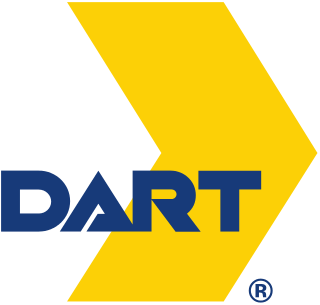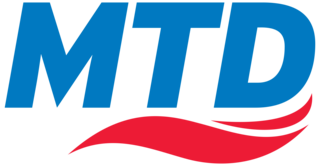
The Southeastern Pennsylvania Transportation Authority (SEPTA) is a regional public transportation authority that operates bus, rapid transit, commuter rail, light rail, and electric trolleybus services for nearly four million people in five counties in and around Philadelphia, Pennsylvania. It also manages projects that maintain, replace and expand its infrastructure, facilities and vehicles.

Dallas Area Rapid Transit (DART) is a transit agency serving the Dallas–Fort Worth metroplex of Texas. It operates buses, light rail, commuter rail, and high-occupancy vehicle lanes in Dallas and twelve of its suburbs. In 2023, the system had a ridership of 50,463,300, or about 166,900 per weekday as of the fourth quarter of 2023.

Hillsborough Area Regional Transit provides public transportation for Hillsborough County, Florida. The agency operates fixed-route local and express bus service, paratransit service, demand-response service, MetroRapid service, and the TECO Line Streetcar system. In 2023, the system had a ridership of 12,929,700.

The Hamilton Street Railway (HSR) is the public transport agency for Hamilton, Ontario. The name is a legacy of the company's early period, when public transit in Hamilton was primarily served by streetcars. Although streetcars are no longer used in the city today, the HSR operates bus and paratransit services, with a ridership of 21 million passengers a year.

King County Metro, officially the King County Metro Transit Department and often shortened to Metro, is the public transit authority of King County, Washington, which includes the city of Seattle. It is the eighth-largest transit bus agency in the United States. In 2023, the system had a ridership of 78,121,600, or about 256,200 per weekday as of the fourth quarter of 2023. Metro employs 2,444 full-time and part-time operators and operates 1,540 buses.

The Edmonton Transit Service (ETS) is the public transit service owned and operated by the City of Edmonton in Alberta, Canada. It operates Edmonton's bus and light rail systems. In 2023, the system had a ridership of 87,646,600, or about 308,300 per weekday as of the fourth quarter of 2023.

The Champaign–Urbana Mass Transit District is a mass transit system that operates in the Champaign–Urbana metropolitan area in eastern Illinois. MTD is headquartered in Urbana and operates its primary hub at the intermodal Illinois Terminal in downtown Champaign. In 2023, the system had a ridership of 8,947,600, or about 34,300 per weekday as of the fourth quarter of 2023.

RTC Transit is the name of the public bus system in the Las Vegas metropolitan area of Clark County, Nevada. It is a subsidiary of the Regional Transportation Commission of Southern Nevada. While it services most of Clark County with regularly scheduled routes, most of the service is in the immediate Las Vegas Valley; outlying places such as Mesquite and Laughlin provide transit services to their residents via the Southern Nevada Transit Coalition, which uses several vehicles acquired from RTC Transit. In 2023, the system had a ridership of 52,734,200, or about 161,000 per weekday as of the fourth quarter of 2023.

The Memphis Area Transit Authority (MATA) is the public transportation provider for Memphis, Tennessee. It is one of the largest transit providers in the state of Tennessee; MATA transports customers in the City of Memphis and parts of Shelby County on fixed-route buses, paratransit vehicles, demand-responsive service, and the MATA Trolley system. The system is managed by a seven-member policy board appointed by the mayor and approved by the Memphis City Council. In 2023, the system had a ridership of 3,122,700.

ABQ RIDE is the local transit agency serving Albuquerque, New Mexico. ABQ RIDE operates a variety of city bus routes including two Albuquerque Rapid Transit (ART) bus rapid transit lines and a currently suspended ARTx express bus line It is the largest public transportation system in the state, serving 6,907,500 passengers in 2023, or about 21,100 per weekday as of the fourth quarter of 2023.
The Valley Metro Regional Public Transportation Authority, more popularly known as Valley Metro, is the unified public brand of the regional transit system for the Phoenix metropolitan area. Within the system, it is divided between Valley Metro Bus, which runs all bus operations, Valley Metro Rail, which is responsible for light rail and streetcar operations in the Valley. In 2023, the combined bus and rail system had a ridership of 36,374,000, or about 122,500 per weekday as of the fourth quarter of 2023.

The London Transit Commission (LTC) is responsible for the operation of the public transit system on behalf of the City of London, Ontario, Canada. It operates transit bus service and para-transit service. In 2014, annual ridership totaled 24.1 million. The LTC has 28 regular bus routes, six express routes, three school-year-only routes and six community bus routes.

Embark is the public transit agency of the COTPA trust, the largest transit agency in the state of Oklahoma. Embark has 20 interconnecting bus routes covering the city of Oklahoma City and parts of the Oklahoma City Metropolitan Area, including weekday Express service from Norman to Downtown Oklahoma City. Embark also operates paratransit, the Oklahoma City Streetcar, downtown public parking, bike share, and river ferry services. Additionally, Embark provides administrative and executive support for the Regional Transportation Authority of Central Oklahoma.

The Detroit Department of Transportation (DDOT) is the primary public transportation operator serving Detroit, Michigan. In existence since 1922, DDOT is a division of the city government, headed by a director appointed by the mayor. Primarily serving Detroit and its enclaves, DDOT is supplemented by suburban service from the Suburban Mobility Authority for Regional Transportation (SMART). In 2023, the system had a ridership of 11,048,700, or about 38,900 per weekday as of the fourth quarter of 2023.

The Rhode Island Public Transit Authority (RIPTA) provides public transportation, primarily buses, in the U.S. state of Rhode Island. The main hub of the RIPTA system is Kennedy Plaza, a large bus terminal in downtown Providence, Rhode Island. Average daily ridership as of the fourth quarter of 2023 is 41,800. The agency operates 59 fixed-route bus routes and 7 demand-responsive routes, together serving 37 out of 39 Rhode Island municipalities.

Tucson Transit Management LLC, doing business as Sun Tran, is the public transit system serving the city of Tucson, Arizona. In 2023, the system had 17,361,800 rides, or about 60,400 per weekday as of the fourth quarter of 2023. 100% of the fleet utilizes clean-burning fuels, such as compressed natural gas (CNG), biodiesel, and hybrid technologies. In addition to more than 40 bus routes, the system also includes the Sun Link modern streetcar line.

The San Diego Metropolitan Transit System is a public transit service provider for central, southern, northeast, and southeast San Diego County, California, as well as for the city of San Diego. The agency directly operates a large transit system that includes the MTS Bus, San Diego Trolley light rail, and Rapid bus rapid transit services. The MTS also controls the San Diego and Arizona Eastern (SD&AE) freight railway and regulates taxicabs, jitneys, and other private for-hire passenger transportation services.
The Pinellas Suncoast Transit Authority (PSTA) is a government agency that provides public transportation for Pinellas County, Florida. The authority manages a fixed-route bus system that encompasses over 40 bus routes - including two express routes to Tampa; the Central Avenue Trolley; the Suncoast Beach Trolley; and the bus rapid transit service, the SunRunner.

Saskatoon Transit is the public transport arm of the City of Saskatoon, Saskatchewan, Canada. It operates a fleet of diesel buses. A total of 23 bus routes serve every area of the city, carrying approximately 11 million passengers in 2008. Saskatoon Transit is a member of the Canadian Urban Transit Association. The major bus terminal is located Downtown.

Knoxville Area Transit (KAT) is the operator of public transportation in Knoxville, Tennessee. Twenty-five routes operate. Service on KAT routes operate weekdays and Saturdays with routes 11, 12, 20, 22, 23, 31, 33, 34 and 41 and 42 offering Sunday service. All routes, except for routes 13,16, 19, 44 and 90 start at the Knoxville Station in Downtown. The Knoxville Trolley is a free shuttle service which provides service to the university and the downtown area. KAT formerly operated the transit service for the University of Tennessee, known as The T. In 2023, the system had a ridership of 2,332,800, or about 8,100 per weekday as of the fourth quarter of 2023.























